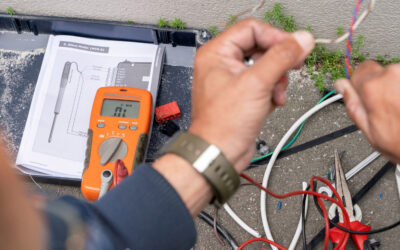Tendering jobs in the electrical and security industry is a part of life – it is how a business can gain new projects and it’s been that way for many years. So why is what should be a simple process to win new work costing businesses so much money?
With more than 20 years experience in the industry, Director of Vision Systems, Tristan Bailey, has worked on his fair share of tenders. His insights can shed light on how the process works and where it all goes wrong – and most importantly, how these mistakes can be avoided.
Here are five examples of how businesses are being burned by the system, and how you can avoid these mistakes.
1. Businesses are working for free
The traditional way of winning work in the industry is to submit a tender offer for a project. Builders, procurement managers, or whoever is managing the project will come to a business – the builder, painter or electrician – and ask for a price to complete the work. Each building discipline will then run through a range of pricing options and increasingly complex range of questions on environmental or H&S practices as well as a number of referrals to submit their proposal and hopefully win the project. The actual cost of undertaking the tender is significant to each business as it can involve a sizable number of hours on a complex bid with a range of staff being involved to get the submission across the line. It’s not standard practice to charge fees, and there’s no regulation to help businesses get paid for the work they’ve done.
2. It’s actually costing you money
Think about more than just the work to pull together the tender itself – the relationships, site visits, supplier communications, coffees, lunches, meetings – that’s all costing you time and money. Are you accounting for this when you are thinking about the cost of a tender project to your business? Is it really worth the time and effort if you don’t win the project?
3. It’s a relationship game
It all comes down to relationships. If you’ve got a good long term relationship with one of the project decision makers, you’ve a good chance of getting the tender. If you get an email from someone on a project and you’ve got no relationship with them, it’s possibly a builder looking for a secondary price.
If you’re new to the market, this can be a huge challenge – forming those relationships so that you’re not being burned by the tender process is critical. The industry is all about knowing when to say yes and when to say no. For example, you may get a builder who you might want to start forming a relationship with, so you’d price the work to get your foot in the door. If you’ve never heard of them or worked with them and they contact you out of the blue, it’s likely they’re using you as a backup option.
4. They don’t know how to price themselves accurately
The competitive nature of the tender market means that companies often underestimate the work involved, or drop their prices down so that they can win the job. There are also many businesses who need to realise they can’t run only on labour rate, they have to have a margin. New companies often don’t understand (or yet know) the cost of running a business, which can mean it’s difficult to have a margin to stick to. They can then be tempted to sign a lesser contract as the true overheads are yet to be a concern, and the number of zero’s on the contract looks promising!
5. The cost to actually complete a project spirals
Time and time again, construction projects will drag on and the work that companies have underpriced themselves for can take months longer than expected. The cost of materials has significantly increased over the years and there are often long lead times on shipments. This is hugely detrimental to so many businesses, especially on a fixed project price as they are legally obliged to complete the works. The obvious outcome is that the project will cost more money, and take up valuable time where they could be working on other projects. Companies may get halfway through a project that they have to complete and the writing is on the wall – it’s a sure-fire recipe for failure.
So what’s the solution to all of this?
Right now, it’s all about your awareness and taking the time to weigh up whether completing a tender is a good move for your business. Think about all of these key things, and ensure that you’re happy with the risks that you’re taking. It’s not all doom and gloom – for all businesses there are challenges that occur when you’re new to the field, but as time goes on you’ll become a pro at learning how to weed out the good from the bad, and decide what’s right for you.





